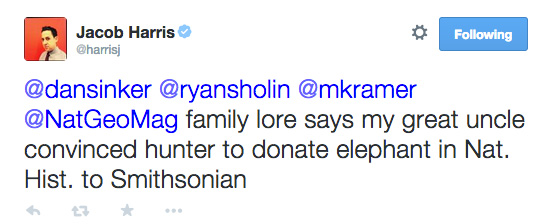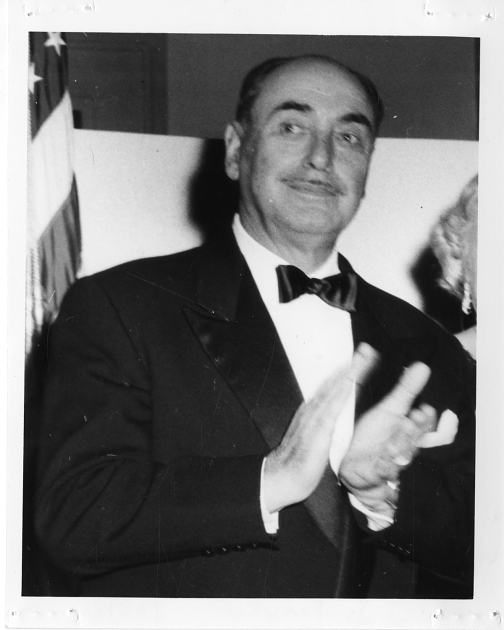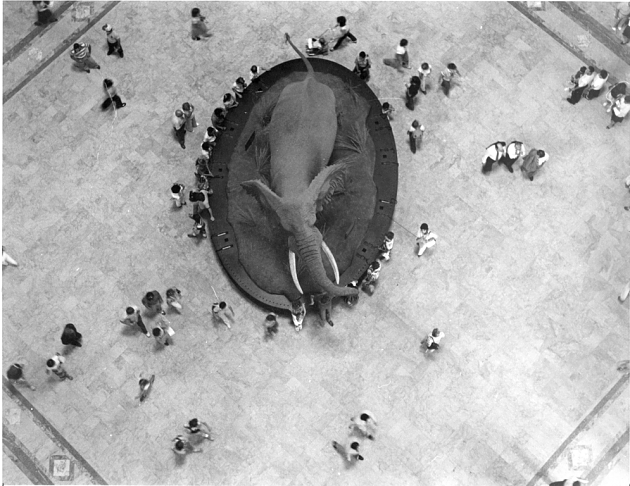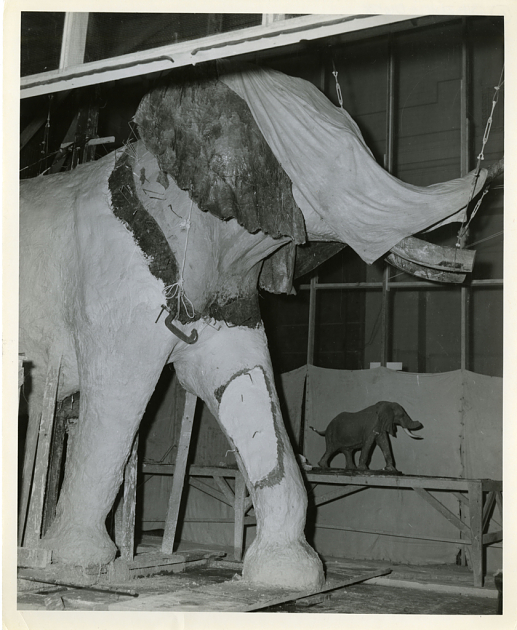
I was intrigued to receive a tweet from a digital colleague over at the NY Times pertaining to a family story that could very well be solved at the Archives. I’m continuously surprised at the variety of papers we hold here, but by now, I shouldn’t be given how far-reaching and varied the scope of the Smithsonian has been through history.
Back to the story.
THE elephant that looms large for every visitor to the National Museum of Natural History (NMNH)? Of course it has a personal connection to someone in the world! What visitors don’t realize is that there is a whole set of circumstances that brought Henry* to sit in his place of prominence in the rotunda of NMNH. The history of how our objects came to the Smithsonian is sometimes thoroughly, and other times, sparsely documented in our accession records. And since the Smithsonian rarely has had the funds to purchase collections, the stories are diverse and fascinating.
 This tweet prompted a dive into Record Unit 305, Accession Records, 1834-1958 (accretions to 1976) that holds the primary documentation of the Smithsonian’s collections as well as information on collecting expeditions, Western U.S. exploration, and Smithsonian history. When reference archivist, Ellen Alers, brought the records to my office, she mentioned the State Department's involvement in this transaction, as well as other of our acquisitions. Sure enough, I found a letter from the American Consulate to Angola, Albert A. Rabida, to the State Department in Washington D.C. It reports that J.J. Fénykövi had visited the consulate and reported on the large bull elephant he hunted and shot in southeast Angola. The December 12, 1955 letter includes details on the size of the elephant, some biographical details on Fénykövi, as well as some insight into Fénykövi’s thoughts on what he intended to do with the specimen:
This tweet prompted a dive into Record Unit 305, Accession Records, 1834-1958 (accretions to 1976) that holds the primary documentation of the Smithsonian’s collections as well as information on collecting expeditions, Western U.S. exploration, and Smithsonian history. When reference archivist, Ellen Alers, brought the records to my office, she mentioned the State Department's involvement in this transaction, as well as other of our acquisitions. Sure enough, I found a letter from the American Consulate to Angola, Albert A. Rabida, to the State Department in Washington D.C. It reports that J.J. Fénykövi had visited the consulate and reported on the large bull elephant he hunted and shot in southeast Angola. The December 12, 1955 letter includes details on the size of the elephant, some biographical details on Fénykövi, as well as some insight into Fénykövi’s thoughts on what he intended to do with the specimen:
“Mr. Fenykovi said that he had furnished a giant sable antelope to the British Museum sometime ago and that he had never received any thanks or acknowledgement for his efforts. Accordingly, it is his intention to furnish the skin of this world record elephant to the Smithsonian Institution or to some other leading American museum of natural history…”
Now THIS is museum gossip at its best! We didn’t waste much time, and on January 6, 1956, United States National Museum (now National Museum of Natural History) Director, Remington Kellogg, cabled Fénykövi expressing our interest in acquiring the large bull elephant. Kellogg graciously offered to cover the shipping from Madrid to D.C.
I relayed these details to Jacob Harris via Twitter which is no small feat. Harris went off to confer with his father, Joseph Harris. The Harris family luckily had done an oral history with Maurice Fogler before he died, and even better, a transcript (a tip to those who looking to preserve their family’s history.) In the transcript, Fogler talks about his friend, a Hungarian engineer (Fénykövi), with whom he used to go partridge hunting in Spain. He also relays details about Fénykövi’s feelings towards the British Museum. These details were too similar to deny a likely connection between Fogler and Fénykövi.
Once the introduction between Fénykövi and the Smithsonian was made, a completely new tale begins which includes discoveries about the bull elephant based on a bullet found in its leg, the gigantic task of shipping and mounting it, a fabulous unveiling at the Natural History building, and a long-term relationship between Fénykövi and the Smithsonian. But, that is for another post.
I loved learning these details about an elephant that is beloved by many D.C. residents and Smithsonian visitors. I also was happy to help add a little evidence to family lore that will last generations.
*Henry is what some children have affectionately come to call the bull elephant, no doubt after the Smithsonian's first Secretary, Joseph Henry.
Related Collections
- Record Unit 305, Accession Records, 1834-1958 (accretions to 1976)
Related Resources
- How Uncle Maurice Saved the Smithsonian Elephant, Bigger Picture Blog
- Collections in Context, Bigger Picture Blog
Produced by the Smithsonian Institution Archives. For copyright questions, please see the Terms of Use.



Leave a Comment